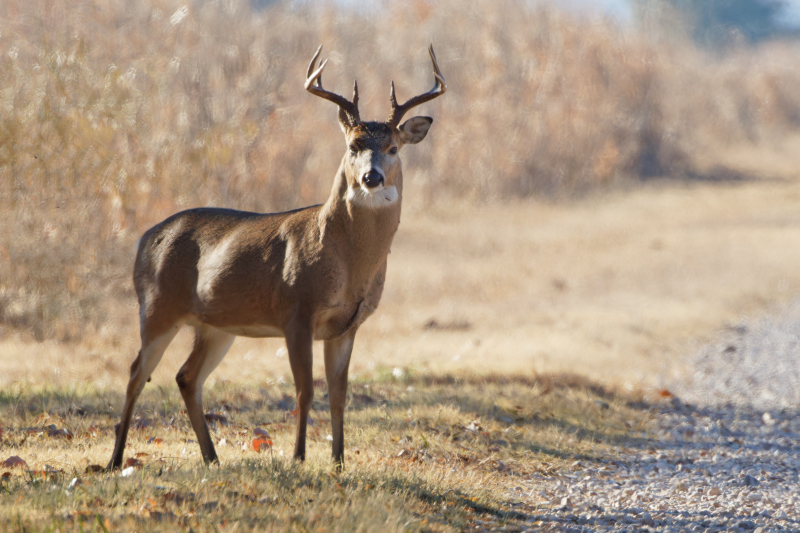I photographed an impressive 8-point white-tailed buck Oklahoma in November at Sequoyah National Wildlife Refuge. This healthy buck was standing on the side of the auto tour road near Miner’s Cove when I captured the first shot. His rack stood out against the brown dormant grasses behind him.

Wildlife Notes
As you can see in the first image, the buck was standing alert, keeping a watchful eye on me as I photographed him from inside my vehicle. His posture showed awareness but not alarm. He was comfortable enough to pause and assess me before continuing his morning routine.
After a few moments, the buck began crossing the road in front of me. I had seen this same animal earlier that morning on the far west side of the refuge near Reeve’s Boat Ramp. Based on that first sighting, I had a hunch he might cross again near Miner’s Cove, so I drove there and waited. My instincts were right.

White-Tailed Buck Behavior During Rut
I noticed this buck had a swollen neck, which is common among white-tailed bucks during breeding season. The increase in testosterone causes their necks to enlarge. Rubbing on trees and saplings also contributes to the swelling by building neck muscle mass, similar to an athlete training with weights. These massive neck muscles make bucks look more intimidating and help them establish dominance over other males during the rut. The added bulk also improves their chances when sparring or pushing rivals away from does.
November is prime rut season in Oklahoma. Bucks are expending huge amounts of energy tracking does, defending territory, and competing with other males. Observing this buck’s movement patterns across the refuge gave me a window into how these animals navigate during this critical period. I’ve written before about my Close Encounter Photographing a Rutting Buck, and these November encounters always reveal how intensely focused bucks become during breeding season.
Photography Notes
I photographed this buck using my Canon EOS R7 paired with the Canon RF 800mm lens. I shot from inside my vehicle, which acts as a mobile blind and keeps wildlife more relaxed. The first image was captured at 9:58 AM on November 22, 2022. Settings were ISO 1600, f/11, 1/1000s, with -0.3 exposure compensation. The morning light was soft and even, which prevented harsh shadows on the buck’s face and antlers.
The R7’s crop sensor gave me extra reach with the 800mm lens, which was critical for maintaining distance while still filling the frame. The f/11 aperture kept the entire deer sharp while softly blurring the background. A faster shutter speed ensured I froze any motion as the buck shifted his weight or turned his head.
I used a beanbag for support, resting the lens on the window frame of my pickup. This setup minimizes camera shake and allows me to track animals smoothly as they move. Shooting from the vehicle also meant I could reposition quickly when the buck started crossing the road.
Closing Thoughts
Encounters like this are what make wildlife photography rewarding for me. Being able to observe animals undisturbed in their natural habitat and capture fleeting moments like these are the experiences I live for. I feel privileged to have seen this healthy 8-pointer on his morning journey before he disappeared into an area closed to the public. Days like this remind me why I became a wildlife photographer in the first place.
